
|
 |
 |
 |
 |
 |
EGG‑NEWS.com
Egg Industry News, Comments & More by
Simon M.Shane
|
 |
 |
 |
 |
 |
 |
Editorial
It All Boils Down to Eggs
|
11/19/2024 |
|
 Notwithstanding the pre-election issues of open borders, ‘democracy’ and women’s health, disaffection with prices of everyday essentials symbolized by eggs was the major driver of the landslide election victory by the President-Elect and Republican down-ticket candidates. Notwithstanding the pre-election issues of open borders, ‘democracy’ and women’s health, disaffection with prices of everyday essentials symbolized by eggs was the major driver of the landslide election victory by the President-Elect and Republican down-ticket candidates.
The price of eggs became the focus of food inflation among voters. Notwithstanding, the reduction in the inflation rate from nine percent in late 2023 to under three percent by November 5th, the electorate rejected the statistics and were motivated by high costs associated with groceries, automobile insurance, rentals, mortgage payments and credit card interest. Despite the fact that inflation has declined, the perception that the economy was mismanaged overruled other considerations, motivating the selection of the top-of-the ticket and members of the House and Senate, even down to the proverbial city dog-catcher.
November 5th has passed, and the trifecta is a reality. The question now is how the economy will fare under the incoming Administration. Deregulation with removal of restraints on mergers and the elimination of onerous “woke” regulations should have a stimulatory effect on the economy. Reduction in government spending, especially in wasteful projects and activities as evidenced by USDA giveaways, should be beneficial in establishing a balance between revenue and expenditure. Adjusting tax rates will benefit both entrepreneurs and corporations with a short-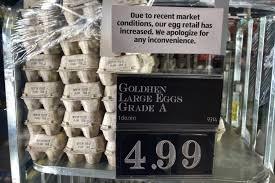 term benefit to shareholders and ultimately to consumers. term benefit to shareholders and ultimately to consumers.
There will however be negative impacts if some pre-election promises are implemented. Imposition of tariffs on imported goods and especially those directed against the People’s Republic of China will be inflationary. It is axiomatic that tariff wars reduce trade and hence U.S. exports. As prices for imported products escalate, domestic producers will increase prices to match those of imported goods. Protectionism also limits innovation and expenditure on research and development. Any observer of economic history will be aware of the effect of the 1930 Smoot-Hawley Tariff Act on exacerbating and extending the Great Depression.
Deportation of illegal immigrants especially those with criminal convictions is justified. It should be recognized that law-abiding foreign workers are necessary, especially for agriculture, given that a proportion of the U.S. population drawing social security and SNAP benefits appear disinclined to take the jobs performed by guest workers. Obviously, the solution is to radically improve immigration legislation and to provide both seasonal and extended-duration visas to workers, preferably with a path to permanent residence as in Canada. Mass deportation would be disruptive and extremely expensive and is fraught with practical problems including undesirable impacts on nations in Central America.
Imposition of tariffs on Mexico could seriously affect agricultural exports since our USMCA partner represents a major importers of corn and soybeans in addition to broiler leg quarters, shell eggs and egg products. The agricultural and industrial structures of the U.S, Canada and Mexico are so integrated that inappropriate and precipitous actions could have severe and far-reaching unintended consequences.
Notwithstanding pre-election rhetoric, it is hoped that economic realities over the coming four years will be tempered by reality and practicality. We look forward to the positive aspects that will benefit the economy. It is anticipated that the more extreme potential negative aspects will be subject to both Executive and Congressional review and restraint.
At the end of the day, voters will have to decide whether they are better off at the 2026 mid-terms and the 2028 general election than they were in 2024. The price of eggs has become an election issue so APHIS had better backtrack on their reluctance to approve regional vaccination to protect egg production and turkey flocks. Politicians will be basing their campaigns on the cost of food and everyday living. The availability and hence price of eggs will be a symbol of the cost of feeding families and will be a determinant of voter satisfaction.

|
APHIS Needs a New Approach to Control HPAI
|
11/13/2024 |
|
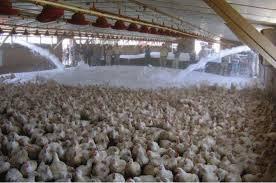 As we move into the midpoint of the fourth quarter, it is evident that the U.S. poultry industry is facing a recurrence of seasonal avian influenza. Outbreaks have claimed 21 million hens year to date with the fall cases amounting to five million hens over six weeks in five states. Effectively APHIS has not changed its approach to control the infection since the 1985 outbreaks in Pennsylvania and adjoining states. Since this time, the impact of HPAI has increased exponentially with expansion of the egg and turkey industries that have been the most affected but with disease having the potential to decimate broiler production. As we move into the midpoint of the fourth quarter, it is evident that the U.S. poultry industry is facing a recurrence of seasonal avian influenza. Outbreaks have claimed 21 million hens year to date with the fall cases amounting to five million hens over six weeks in five states. Effectively APHIS has not changed its approach to control the infection since the 1985 outbreaks in Pennsylvania and adjoining states. Since this time, the impact of HPAI has increased exponentially with expansion of the egg and turkey industries that have been the most affected but with disease having the potential to decimate broiler production.
It is evident that diagnosis of HPAI has been facilitated by recent technological advancements including PCR and lateral flow immunodiffusion assay kits. From bitter experience, state and federal agencies are now able to rapidly confirm HPAI and then quarantine and dispose of infected flocks. Notwithstanding experience in depopulating large caged-hen and aviary egg production complexes, it may take more than five days to euthanize and dispose of a flock comprising one million or more hens.

It is time that APHIS recognized that HPAI is at least seasonally and regionally endemic with migratory waterfowl and marine birds serving as reservoirs and disseminators of virus each fall and spring. Given the duration of the current epornitic it is possible that domestic, resident avian and mammalian species may perpetuate infection that can be transmitted to commercial poultry.
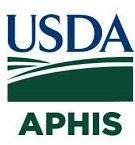 Despite seasonal reoccurrence of the infection since 2022, APHIS has pursued a futile policy of attempting to “stamp out” the infection. This approach would be justified if an exotic viral disease were to be imported into the U.S. and introduced onto a single farm through defective biosecurity. Eradication would be possible with rapid diagnosis and expedient depopulation and disposal of carcasses. The reality of HPAI is far different from the situation envisaged in the APHIS conceptual model. With respect to HPAI, “stamping out” in the classic sense is inappropriate, outdated and inconsistent with epidemiologic reality. Despite seasonal reoccurrence of the infection since 2022, APHIS has pursued a futile policy of attempting to “stamp out” the infection. This approach would be justified if an exotic viral disease were to be imported into the U.S. and introduced onto a single farm through defective biosecurity. Eradication would be possible with rapid diagnosis and expedient depopulation and disposal of carcasses. The reality of HPAI is far different from the situation envisaged in the APHIS conceptual model. With respect to HPAI, “stamping out” in the classic sense is inappropriate, outdated and inconsistent with epidemiologic reality.
APHIS has at its disposal personnel with experience in field epidemiology. Despite this resource, the Agency has not conducted thorough epidemiologic investigations relating to the mode of transmission of virus from migratory bird reservoirs to farms. The belated and incomplete publications on outbreaks during 2022 failed to identify what is evident to poultry health professionals in North America. It appears that the infection can be transmitted over distances of up to a mile by the aerogenous route. APHIS has failed to publish on any structured evaluation of environmental variables that may influence transmission or viability of H5N1 virus including humidity, wind movement, cloud cover or temperature. A number of scientific studies have confirmed the possibility of aerogenous transmission as reported in 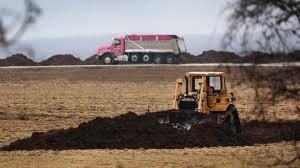 EGG-NEWS during the past year. If it is accepted that avian influenza virus can be transmitted on entrained dust or soil particles then even the most rigorous structural and operational biosecurity will not provide absolute protection for power-ventilated houses as denoted by the circumstances associated with a number of outbreaks. EGG-NEWS during the past year. If it is accepted that avian influenza virus can be transmitted on entrained dust or soil particles then even the most rigorous structural and operational biosecurity will not provide absolute protection for power-ventilated houses as denoted by the circumstances associated with a number of outbreaks.
It is questioned whether APHIS administrators actually want to know how the virus enters farms. To accept that the infection is seasonally and regionally endemic and is transmitted by air movement over as yet undetermined distances, presumes that stamping out will not be possible. Seasonal reintroduction of H5 and H7 influenza viruses predicates a new approach.
Attempting to eradicate avian influenza in commercial flocks by serial depopulation imposes a cost on the public sector through indemnity and logistics. Producers lose income while replacing flocks. Welfare advocates including legislators have condemned extensive depopulation including VSD. The cost of uncontrolled infection for consumers is immense, overshadowing direct costs for control. Depopulation of over 50 million hens during the 2022-2023 epornitic resulted in a constant reduction in the national flock by at least 10 million laying hens resulting in a conservative incremental cost of $2 per dozen spread over 12 months. With domestic sales of shell eggs and products amounting to seven billion dozen, consumers paid an incremental $15 billion as a result of the prolonged and uncontrolled infection. A similar situation is playing out in 2024 with the total flock approximately 12 million under the pre-HPAI level of 326 million.
The adaptation of H5N1 avian virus to dairy herds has created an additional problem for the poultry industry in addition to milk producers. To date, there have been 492 diagnosed cases of bovine influenza among dairy herds. This figure is in all probability an undercount given the reluctance of states other than California and Colorado to impose rigorous surveillance programs based on assay of bulk milk. California has diagnosed 278 cases within three months despite a program of rapid diagnosis with mandatory quarantines. Bovine influenza-H5N1 is a risk to poultry as evidenced by spillovers to farms in Michigan, Utah and Colorado and possibly in the Central Valley of California. APHIS has yet to release the results of epidemiologic studies that presumably have been conducted on the transmission of H5N1 strain B3.13 in the dairy industry.
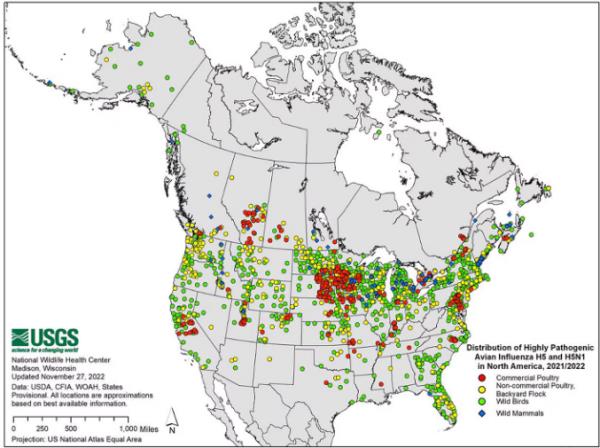 |
The zoonotic aspect of H5N1 influenza virus is a growing concern. Although a reassortment event may result in a strain with both human and avian genes becoming infectious to humans, additional mutations will be required for contagion necessary to precipitate an epidemic. The consequences of an H5 influenza pandemic would far exceed the economic and health effects of the SARS-CoV-19 pandemic. The quicker that the virus can be suppressed in the commercial poultry industry, the safer our population will be.
Creating immune poultry populations especially in areas with a high density of egg or turkey production and with large in-line complexes will reduce the financial impact of avian influenza and mitigate against emergence of a zoonotic strain. The World Organization of Animal Health accepts the principle of immunization as an adjunct to biosecurity and quarantine to control the infection. France and Mexico have successfully deployed vaccination to reduce incidence rates. It is axiomatic that avian influenza is the Newcastle disease of the 2020s. This infection was as catastrophic with respect to commercial production in the 1960s as avian influenza is at the present time. Newcastle disease is effectively controlled by vaccination. Vaccination is obviously not perfect since nothing in biology is absolute.
We are all too aware of the trade restraints associated with vaccination. If, however, the infection emerges in high-density broiler production areas of the U.S. or if Brazil, the major world exporter of broiler products, encounters (or admits) to infection among commercial flocks, the approach of blanket national restrictions would fall away. Importing nations should be guided by the World Organization for Animal Health principles of compartmentalization and regionalization and controlled application of vaccination. The incidence rate of avian influenza in the U.S. with the costs to both private and public sectors and the obvious futility of applying a “stamping out” program predicates immunization using available vaccines on a limited and controlled basis. Turkeys and commercial egg production flocks, especially in areas of high risk, should receive priority consideration. Vaccination of broiler breeder flocks or even commercial growing birds would be based on cost to benefit studies taking into account risks of infection, the financial impact of losses and also trade considerations that may have been overstated.
What is evident is that the program APHIS has following for three years is flat just not working. Hope that migratory birds will cease shedding is not a viable strategy. Current administrators of APHIS should step back from their present policy and restraints and reconsider the limited application of vaccination to protect flocks at the greatest risk based on the history of regional exposure.
Any representative or spokesperson for APHIS or colleagues who wishes to defend the status quo or advance the principle of limited and controlled vaccination is welcome to submit a comment to be posted.

|
The People Have Spoken
|
11/06/2024 |
|
 Both in the plurality and by state, the incoming President and his Administration have a clear mandate. Let us hope that stability in both domestic and foreign policy will prevail and that prosperity will improve. Initial indications from the stock market suggest approval of policies advocated during the pre-election period. The concurrent rise in interest rates predicts that borrowing will escalate and that the national debt will continue its upward trajectory to become a problem for our children and grandchildren. Both in the plurality and by state, the incoming President and his Administration have a clear mandate. Let us hope that stability in both domestic and foreign policy will prevail and that prosperity will improve. Initial indications from the stock market suggest approval of policies advocated during the pre-election period. The concurrent rise in interest rates predicts that borrowing will escalate and that the national debt will continue its upward trajectory to become a problem for our children and grandchildren.
The overwhelming consideration for the agricultural sector will be the proposed imposition of protective and in some cases punitive tariffs that will restrict exports of commodities. With respect to soybeans, Brazil and Argentina represent efficient competitors with adequate production. With the loss of the market represented by China and some other nations, prices will fall to the disadvantage of row crop farmers but will benefit livestock producers including broilers, turkeys and eggs. Since the broiler industry exports leg quarters, basically a commodity, most importers who are unaffected by U.S. tariffs will continue to buy the product, based on need and price.
 The imposition of tariffs will increase the price of imported equipment, especially over the short term, but will ultimately encourage local manufacture and fabrication. The imposition of tariffs will increase the price of imported equipment, especially over the short term, but will ultimately encourage local manufacture and fabrication.
There will be profound changes in policy and operation at USDA. It is hoped that the lame duck session of the 118th Congress will produce a viable Farm Bill, delayed since 2023, with most provisions having expired at the end of September. Benefits that have been extended to minorities and small producers in the form of special programs that are essentially giveaways will cease under the new Administration, focusing on productivity and rationality and less on ideological considerations. The move towards “restructuring” the meat and poultry industries will disappear with large plants operated by the major producers continuing to provide the bulk of red meat. Numerous current antitrust activities will be terminated with replacement of extremists in the FTC and DOJ, exercising their respective sociopolitical agendas.
The question of immigration will require balance. It is hoped that a comprehensive review of policy will lead to enactment of fair and constructive legislation. While it is considered appropriate to deport criminals and those who have illegally entered the Nation, it must be remembered that agriculture relies on foreign labor. Legal routes to entry and employment must be revised and extended but should also be strictly enforced.
The incoming Administration has a mandate to govern according to the platform presented to the electorate. Let us hope that both the Executive and Legislative branches recognize their responsibilities to the Nation to work cooperatively for the benefit of the total economy and especially the agricultural community responsible for our health and prosperity.
God bless America!

|
U.S. Prosperity Should Dominate Electoral Decisions
|
10/30/2024 |
|
 As the U.S. faces a pivotal national election, the future economic well-being of the U.S. should be the overriding decision in assigning votes, overriding political rhetoric. The economy of the U.S. is sound by any economic measure. The GDP of our Nation comprises 50 percent of the other G7 nations combined, up from 40 percent in 1990. Per capita GDP contribution is 30 percent higher than for the E.U. and 60 percent higher than Japan, according to a review of the U.S. economy in the October 19th edition of The Economist. As the U.S. faces a pivotal national election, the future economic well-being of the U.S. should be the overriding decision in assigning votes, overriding political rhetoric. The economy of the U.S. is sound by any economic measure. The GDP of our Nation comprises 50 percent of the other G7 nations combined, up from 40 percent in 1990. Per capita GDP contribution is 30 percent higher than for the E.U. and 60 percent higher than Japan, according to a review of the U.S. economy in the October 19th edition of The Economist.
This article noted the inherent advantages enjoyed by the U.S. including energy resources, a vast consumer market and relative to the E.U., fewer restrictive regulation leading to the rise of companies applying high technology. The U.S. dollar remains the world’s reserve currency. According to the International Monetary Fund the U.S. dollar comprises sixty percent of the reserves held by central banks. Given the strength of agriculture and industry coupled with adoption of innovative technology and sound management, the average American worker generates $171,000 in economic output compared to $120,000 in the E.U. Our productivity has increased 70 percent since 1990 compared to 30 percent in Europe and 25 percent in Japan.

We weathered the global fiscal crisis of 2008 avoiding a fiscal meltdown . We responded to the COVID pandemic with massive spending that cushioned the economy and prevented extensive social hardship. The resulting inflation was however “tamed” by successively increasing the benchmark interest rate without generating unemployment and achieving a “soft landing” without creating a recession as has occurred in previous cycles. The fiscal stimulus packages resulted in the U.S. recovering from the pandemic more quickly than other industrialized nations. The balanced recovery has placed the U.S. in a more favorable situation than its peers and competitors.
Ironically, factors that have contributed to the strength of the U.S. economy including immigration have been demonized in the pre-election period. A regulated flow of immigrants is necessary to offset a decline in population growth. Qualified entrants have most certainly contributed to economic well-being in a variety of sectors including high technology, health and manufacturing. Unskilled workers have supported agriculture and are necessary to perform work that U.S. citizens are disinclined to do.
On the negative side, life expectancy in the U.S. has declined due to health issues centering on obesity, gun violence, opioid addiction and an unacceptable rate of child mortality. Older Americans have a lower life expectancy after 65 than their peers in the E.U.
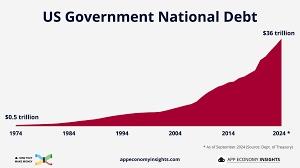
Despite the remarkable progress over the past three decades, there are clouds on the horizon and the U.S. may suffer from injudicious politically inspired economic decisions. The debt-to-GDP ratio has nearly tripled since the outbreak of the global financial crisis of 2008 attaining 103 percent at present. Economists forecast deterioration in this parameter with the debt-to- GDP ratio peaking at 160 percent within three decades unless spending is curtailed. In 2016, the national debt stood at $25.6 trillion, rising to $32.6 trillion in 2020 and now stands at $35.8 trillion. Interest on the national debt represents seven percent of GDP at present but could soar to 12 percent in 2035.
Economic platforms proposed by the two competing presidential candidates promise little to reduce debt. One candidate intends to reduce taxes on overtime earnings and tips representing $118 billion over ten years in addition to providing tax breaks on car loans. Proposed SALT deductions could boost national debt by $1 trillion over 10 years. These pre-election promises are intended to attract support from voters in pivotal states. The other candidate is promising $25,000 to aspirant homeowners coupled with a program to erect three million dwellings togetherwith substantial tax breaks directed to the “middle class”. Many of the proposals from both candidates will probably never eventuate given that they must receive Congressional approval.
|
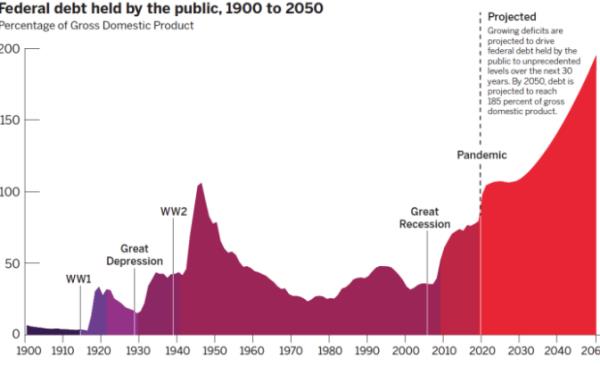
|
Economists have condemned the intention to place high tariffs on imported goods in an attempt to replace taxes with tariffs. In addition, punitive tariffs applied as a surrogate for diplomacy will reduce agricultural exports and will severely impact rural communities that support an essentially isolationist policy without realizing the implications.
Pre-election rhetoric promising high tariffs and massive deportations and considerations such as interference by the White House in the Federal Reserve will create self-inflicted wounds. Unrestricted spending on social programs and a continuation of antitrust activities including opposition to large and efficient meat and poultry production will be detrimental to specific sectors of the economy and to the nation at large.
Irrespective of the outcome of the election, the winner must address the growing budget deficit that is now equivalent to seven percent of GDP. Ultimately, our well-being will be dependent on productivity and population growth. Fiscal programs presented by both candidates for the Presidency are unworkable and unrealistic. Let us hope that these are merely empty political gestures to win votes. Irrespective of the outcome of the election the incoming Administration in 2025 will have to adopt sound fiscal policies. Congress will have to be more accommodative, less partisan and willing to pass legislation through compromise in order to advance the economic well-being of the Nation and its citizenry.

|
Bovine Influenza in Central Valley, CA. Associated with Elevated Cow Mortality
|
10/21/2024 |
|

Unlike cases of bovine influenza in Texas, Colorado and eleven other states, mortality among affected herds in the Central Valley of California has assumed concerning proportions. To date, over 120 herds have been diagnosed with H5N1 B3.13 strain with some operations recording 15-20 percent mortality compared to less than five percent in other states collectively recording 210 cases to date. Although ambient heat has been implicated as a stress factor contributing to mortality, it is noted that temperatures in the Central Valley frequently exceed 100F without resulting in an appreciable elevation in losses.

Rendering companies are overwhelmed and carcasses have been stacked in the open in areas close to herds adding to the risk of contamination of soil followed by dispersal by wind, carrion birds or mammalian vermin.
It is of extreme urgency that the whole genome sequence of isolates associated with high mortality in cows should be analyzed to determine if there has been a shift in pathogenicity to animals and humans due to mutation.
It is noted that eleven dairy herd workers have been diagnosed with H5N1v influenza. Epidemiologic studies should be conducted to determine risk factors other than those that are currently recognized and to determine whether appropriate PPE was issued and used by those who were infected. Surveillance to ascertain whether domestic contacts of those affected yielded H5N1v virus on PCR appears necessary to determine whether the virus has become contagious among humans. It is also necessary to conduct serologic surveys on workers and their immediate contacts for individuals known to have been infected based on clinical symptoms or PCR assay as compared to those who were unaffected. On Tuesday 20th October health officials in Washington state reported five workers with conjunctivitis and respiratory symptoms associated with the affected farm in Franklin County. Whether these individuals were infected as part of their routine flock duties or were part of a depopulation team has not been announced but it is anticipated that information will be made available to the WHO after samples have been collected and expeditiously analyzed.

In the interim, it is presumed that the California Department of Food and Agriculture is actively following a program of surveillance in order that affected herds can be quarantined as far as possible. It is hoped that epidemiologic studies in progress will identify risk factors and vehicles of transmission.
The occurrence of cases of H5N1v infection in farm workers in contact with dairy herds and infected egg-production flocks requires more follow up. Assay for H5N1 antibody among potentially exposed but unaffected individuals will be required. Determining how and when individuals were infected, duration of shedding virus from the respiratory tract requires structured investigation both at the field and molecular levels.
Despite the USDA/CDC contention that H5N1 strain B3.13 responsible for bovine influenza does not represent a risk for human population in affected areas, more transparency by public agencies would be reassuring.

|
Kroger Makes a Case for Merger with Albertsons
|
10/14/2024 |
|
 The October 11th edition of EGG-NEWS included a posting on the arguments advanced by the Federal Trade Commission (FTC) in cases heard in Oregon, Washington State and Colorado seeking to block the proposed merger between the Kroger Company and Albertsons Corporation. The parties to the merger countered with arguments refuting FTC assertions and supporting the transaction. The October 11th edition of EGG-NEWS included a posting on the arguments advanced by the Federal Trade Commission (FTC) in cases heard in Oregon, Washington State and Colorado seeking to block the proposed merger between the Kroger Company and Albertsons Corporation. The parties to the merger countered with arguments refuting FTC assertions and supporting the transaction.
Kroger and Albertsons contend that the FTC is conducting a “trial-by-anecdote” and that their justification for opposing the merger is based on faulty concepts and a distorted characterization of the grocery industry. The two merger parties maintain that considerable competition exists in the grocery industry. This includes online purchasing through Amazon and the services operated by the major chains including Walmart and Target. Warehouse stores including Costco and Sam’s Club that have expanded now represent competition to conventional pure-play grocery chains especially in the suburbs of large population centers. The location of small independent and specialty grocers again in suburban areas compete with traditional chains.  The ubiquitous dollar stores that serve inner city and rural areas, especially in the Midwest and Western states, do not in fact represent competition to Kroger and Albertson’s banners, despite representations advanced during the lawsuits in Colorado, Washington and Oregon. The proposed merger would in many states with low-density populations, reduce competition especially with the potential failure of the divested stores, to the disadvantage of consumers in small towns and cities in rural areas. The ubiquitous dollar stores that serve inner city and rural areas, especially in the Midwest and Western states, do not in fact represent competition to Kroger and Albertson’s banners, despite representations advanced during the lawsuits in Colorado, Washington and Oregon. The proposed merger would in many states with low-density populations, reduce competition especially with the potential failure of the divested stores, to the disadvantage of consumers in small towns and cities in rural areas.
Kroger presented evidence that the purchasing patterns of consumers have changed over a decade and that they are now less reliant on a single banner for their groceries, frequently patronizing many different stores within a week. This may be a valid contention but is probably limited to areas of high density including the suburbs of large metropolitan areas. This is not necessarily applicable to the residents of Logan, UT., Bozeman, MT., Kingman, AZ. and hundreds more locations offering limited choice.
Kroger has indicated that it will deploy $1 billion to reduce prices within a short time of the merger taking place and will invest in store upgrades and benefits for workers. A non-binding promise in anticipation of the merger might be viewed as an inducement to secure approval but would be repaid in any given year by increasing markup by a fraction of a percent on the projected combined FY 2024 sales of the two companies, approximating $250 billion. Kroger management recognizes the potential for increases in margin in the absence of viable competition in Western states coupled with the economies of scale from consolidated buying and transport.
Albertsons Corporation through its CEO Vivek Sankaran maintained that without the synergy generated by the proposed merger, Albertsons would be obliged to close stores and exit some markets resulting in layoffs and inconvenience to consumers.
The parties to the transaction noted their intention of divesting 579 stores, a requirement that would have been imposed by the FTC under any Administration. Evidence in the Colorado trial confirmed that both Aldi and SaveMart were intereted in acquiring the stores representing substantial competition. In the event Kroger-Albertsons selected C& S Wholesalers to acquire the complete package of stores and DCs.To ensure viability, C&S iwill be staffed through transfer of experienced managers and their teams headed by the COO of Albertsons to ensure viability but with the obvious prospect of continued control. The intent is probably to sustain viability of C&S for a reasonable period but not represent any meaningful competition. The recent history of the demise of Haggen following acquisition of divested Safeway stores in 2015 and the apparent "synthetic" divestiture of 579 stores will be considered by the Courts as a justification to reject the merger.
In the context of dairy, eggs, produce and even packaged foods, the combined buying power of Albertsons and Kroger, especially in western states would be detrimental to farmers and suppliers.
Decisions have yet to be rendered in the three cases, but informed observers believe that the application for a preliminary injunction preventing the merger will be granted by the Federal Court in Oregon. It is also more likely that adverse verdicts will be rendered in both Oregon and Washington State, effectively torpedoing the transaction.
Based on the reported evidence presented at the three trials coupled with press releases by Kroger, the merger would benefit Cerberus Capital Management, shareholders of the Kroger Company and executives with ‘golden parachutes’. The proposal would appear to represent a zero-sum transaction with losers comprising farmers and suppliers of perishables including eggs and consumers deprived of alternative grocery retailers especially in underserved regions and areas in the rural U.S.

|
Dutch Study Confirms Airborne Dissemination of DNA from Waterfowl into Poultry Houses
|
10/07/2024 |
|
 A recently published study* conducted by epidemiologists and molecular biologists affiliated with Utrecht University and Wageningen Bioveterinary Research confirmed that DNA from waterfowl could be detected in the incoming air stream of poultry houses. A recently published study* conducted by epidemiologists and molecular biologists affiliated with Utrecht University and Wageningen Bioveterinary Research confirmed that DNA from waterfowl could be detected in the incoming air stream of poultry houses.
The study involved two broiler houses and a layer house that were depopulated and decontaminated after confirmed cases of H5N1 HPAI. The area in which the study was conducted was known to have a noteworthy population of waterfowl. The houses selected for assay were devoid of flocks with the exception of a few sentinel chickens in the layer house. Ventilation systems were operated consistent to the respective requirements of flocks that would have been housed. Air sampling equipment was placed directly at the air inlets. In addition parallel samples were obtained from the exterior of the sampled houses. DNA was extracted and isolated from sample filters and was assayed by applying eukaryote DNA metabarcoding followed by deep sequencing.
In the case of the two broiler houses on the respective farms, 1 out of 5 and 1 out of 21 air inlet samples respectively yielded DNA derived from waterfowl. For the layer house, 2 out of 21 samples were positive. One out of 21 exterior samples was positive for waterfowl DNA from only one of the two broiler farms and 2 out of 21 samples yielded waterfowl DNA in the vicinity of the layer farm.
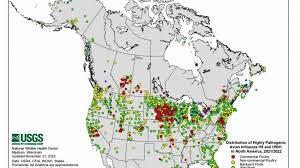
The positive control comprised samples obtained from a waterfowl rehabilitation center. All twelve out indoor samples and all 8 outdoor samples yielded waterfowl DNA. This was not unexpected, but confirmed the sensitivity of detection of waterfowl DNA using the sampling and assay technique.
Demonstration of HPAI virus in air samples is exceptionally difficult but has been demonstrated using spike-in experiments. In addition HPAI H5N1 was isolated from air samples obtained in the vicinity of wild waterfowl in a study conducted in Taiwan coincident with outbreaks in commercial poultry. This study demonstrated that DNA from the plumage of waterfowl or their feces may be entrained in air streams with introduction into poultry houses operated with exhaust ventilation. It is noted that air samples were obtained over distances ranging from 12 to 25m from each of the houses sampled over a period of four days.
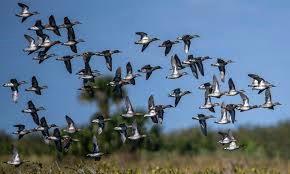
The study demonstrated that commercial poultry confined to power-ventilated buildings may potentially be exposed to avian influenza virus since DNA from waterfowl was detected in the airflow at the air inlets to houses. In the context of units holding 100,000 laying hens, air flow would correspond to 600,000 cfm assuming 1.5 cfm per pound live weight. Air inlet velocities would approach 600 ft/minute at the inlets depending on their collective area and the rating and number of fans in operation. The introduction of HPAI virus into a large complex is obviously facilitated by the quantum of air introduced into houses under normal operation, environmental variables promoting survival of virus and proximity to concentrations of migratory waterfowl shedding virus.
HPAI virus can persist on moist soil for periods extending beyond a week. The presence of waterfowl in vicinity of large egg-production complexes along the Mississippi Flyway is well established. Effluent retention ponds in the vicinity of houses, and the presence of wetlands attract waterfowl. In a recent evaluation of biosecurity of a complex in a Midwest state, gulls, were perching on the ridges of houses and Canada geese ranged to within yards of the perimeter of houses feeding on grass between houses.

The implications of the University of Utrecht/Wageningen study are self-evident. Even with the highest standards of biosecurity, introduction of avian influenza virus cannot be absolutely prevented. This is consistent with anecdotal reports of exposure on complexes with high levels of structural and operational biosecurity in Colorado and other states.
Filtration of incoming air to exclude virus is currently impractical but the use of laser installations to deter congregation of wild waterfowl and other birds in the vicinity of farms should be beneficial.
With the recognition that HPAI is at least seasonally and regionally endemic in the U.S. and given the population of migratory waterfowl and resident birds potentially shedding avian influenza virus, eradication of the infection can only be regarded as a futile aspiration. With new evidence highly suggestive of aerogenous transmission of the virus, protection of both large and medium sized complexes and even individual houses would be enhanced by immunization. The World Organization for Animal Health has endorsed preventive vaccination in conjunction with high levels of structural and operational biosecurity to offer a more solid prospect of preventing large-scale outbreaks.
*Bossers, A., et al. Detection of Airborne Wild Waterbird-Derived DNA Demonstrates Potential for Transmission of Avian Influenza Virus via Inlets into Poultry Houses, the Netherlands, 2021-2022. Euro Surveill. 2024:29 Doi.org/10.2807/1560-7917.ES.2024.29.40.2400350.

|
Pressure is Mounting for HPAI Vaccination
|
09/30/2024 |
|
 Currently, the poultry industry is in a relatively inactive stage with respect to incident cases of highly pathogenic avian influenza (HPAI). This may change during fall months with the onset of southward migration of waterfowl and also dissemination of virus by domestic birds. In addition, 2024 witnessed the emergence of bovine influenza-H5N1 with spillover to poultry complexes in Michigan and Colorado and probably responsible for the September case on a turkey farm in Merced County, California. Currently, the poultry industry is in a relatively inactive stage with respect to incident cases of highly pathogenic avian influenza (HPAI). This may change during fall months with the onset of southward migration of waterfowl and also dissemination of virus by domestic birds. In addition, 2024 witnessed the emergence of bovine influenza-H5N1 with spillover to poultry complexes in Michigan and Colorado and probably responsible for the September case on a turkey farm in Merced County, California.
Highly pathogenic avian influenza should be regarded as seasonally and regionally endemic if not by definition ‘endemic’ in the U.S. This is based on the duration of the epornitic and the geographic extent of outbreaks.
Recently, Marcus Rust, CEO of Rose Acre Farms, the second-ranked egg producer by volume, advocated for vaccination in an interview with Reuters. Rust noted, “We are farmers, and we want our animals to live.” Along with competitors his family company has suffered losses from HPAI and has relocated a farm to establish conceptual biosecurity. The USDA- APHIS should recognize that the infection is endemic at least regionally and seasonally. Since the virus can be spread over even relatively short distances by the aerogenous route, even the most intensive biosecurity is inadequate to provide absolute protection. APHIS should recognize that the infection is endemic at least regionally and seasonally. Since the virus can be spread over even relatively short distances by the aerogenous route, even the most intensive biosecurity is inadequate to provide absolute protection.
A number of legislators are pressing USDA to review their no-vaccination policy with respect to practicality and cost. Vaccination to protect flocks against HPAI is a bipartisan issue as denoted by the representations to USDA by Representatives Randy Feenstra (R-IA) and Jim Costa (D-CA). The Agency appears to be unresponsive, citing real or perceived concerns over export of broiler leg quarters. This is an important and valid consideration although whether absolute is subject to question. The export restraint should not be a deal-breaker to the detriment of the entire poultry industry. In calculating costs, USDA appears to ignore the effect of HPAI on consumers. It is calculated that with seven billion dozen eggs sold in 2022, and at an average increase of $2 per dozen over the year consumers paid an additional $14 billion for their eggs. The additional cost was due to disequilibrium between supply and demand with as many as 50 million hens depopulated as a result of HPAI over the year. Currently the U.S. hen population is approximately 18 million lower than the pre-HPAI level of 326 million despite routine repopulation and retention of flocks. Eggs demonstrate noteworthy price elasticity resulting in large fluctuations in either direction caused by small differences in supply. Unfortunately, this reality is fueled by the prevailing price discovery system that enables buyers to bend the market over the short term by holding back on orders, inducing a fall in price and then restocking DCs and shelves.

USDA also appears refractory to the issue of possible emergence of a pandemic of a zoonotic strain of HPAI. Mutations resulting in the emergence of the B3.13 variant capable of propagating in mammary tissue of dairy cows and resulting in mild conjunctivitis and upper respiratory infection should be an additional justification to reduce the number of susceptible commercial hens and turkeys through vaccination.
Commercially available vaccines could be purchased from multinational suppliers on an off-the shelf basis but this will require USDA approval for administration in the U.S. Claiming that additional research for development of a new or specific “U.S. vaccine” would be necessary is simply a delaying tactic to avoid making a policy decision. Accepting vaccination would effectively recognize the futility of efforts by the USDA to eradicate HPAI since the 2015 epornitic. Opposition to vaccination that appears inherent to APHIS thinking is now largely invalid given the availability of PCR assay to certify flocks free of infection and to distinguish between infected and immunized commercial flocks and regional populations.
It is hoped that reality will convince USDA administrators of the need to allow vaccination against HPAI as an adjunct to structural and operational biosecurity. It is envisaged that initially vaccination would be limited to turkeys, breeders and laying hens in high-risk areas. This would be coupled with surveillance and certification to meet the challenge of exports.
For too long, USDA-APHIS has clung to an outmoded and ineffective policy of attempting to eradicate an endemic infection. Given the reservoir comprising domestic migratory waterfowl and introduction by migratory marine species of birds, USDA is ignoring epidemiologic reality at considerable cost to producers, consumers and the national debt.

|
Kroger Case Concludes in Oregon – Commences in Washington. Colorado and D.C. Hearings Scheduled
|
09/25/2024 |
|

The application by the Federal Trade Commission for a preliminary injunction to block the proposed merger between the Kroger Company and Albertsons Corporation concluded on September 17th. U.S. District Judge Adrienne Nelson indicated that she would render her verdict in due course following a review of evidence and the written arguments to be submitted by the FTC and Kroger.
The second case in which the state of Washington is attempting to block the merger commenced this past week to be followed by a similar action in Colorado both initiated by the respective state Attorneys General.

The Federal Trade Commission has scheduled a hearing on the proposed merger to take place in Washington, DC. before an administrative law judge. Kroger has filed suit against the FTC alleging that the internal hearing would be unconstitutional.
Observers have suggested that in the event of an adverse verdict in Oregon, the proposed merger would be terminated. Kroger has committed considerable resources to supporting the transaction and faces a “walk away” penalty if the merger is not concluded.
The evidence presented at the Washington State hearing brought by A/G Bob Ferguson to block the deal includes:-
- The reality that the two companies combined represent half of grocery sales in the state and are effectively competitors. Allowing a merger would decrease competition to the detriment of consumers
- Divestment of 124 stores in the transaction to C & S wholesalers is regarded as a non-viable strategy to maintain competition. This argument is based on the 2015 Haggen debacle in which stores divested in the Albertsons-Safeway merger reverted to Albertsons
- Both Albertsons and Kroger are able to compete profitably against Walmart, Amazon and the dollar stores as individual chains without a merger

From the narrow perspective of egg producers and other suppliers especially produce and perishables, the merger would expand the existing buying power of both chains to create a formidable adversary in pricing.
Subscribers to EGG-NEWS are referred to the special edition mailed on September 23rd accessed using the link:
Kroger / Albertsons Merger
This edition reproduces selected reprints of articles posted since the 2022 announcement of the proposed merger. Articles detail the opposition by unions, and Attorneys General of impacted states. Arguments advanced by the FTC concerning competition and rejection of the plan to divest stores and distribution centers to C & S Wholesalers were topics reported among 47 postings.

|
Investigations of Isolated H5 Influenza Case Continuing
|
09/16/2024 |
|
 According to Dr. Nirav Shah, Principal Deputy Director of the Centers for Disease Control and Prevention, laboratory investigations are continuing on the isolated and spontaneous case of H5N1 influenza diagnosed in a patient in Missouri. According to Dr. Nirav Shah, Principal Deputy Director of the Centers for Disease Control and Prevention, laboratory investigations are continuing on the isolated and spontaneous case of H5N1 influenza diagnosed in a patient in Missouri.
In a September 13th release the CDC confirmed the neuraminidase component of the virus as N1. Sequencing has yet to be completed although initial indications are that the virus belongs to clade 2.3.4.4b and is similar to the mammalian adapted H5N1 B3.13 strain circulating among dairy cattle and contacts including cats and rodents. The HA sequence disclosed two amino acid substitutions. According to a ProMED posting, Dr. Jesse Bloom at Fred Hutchinson Cancer Center, noted that the A156T mutation is associated with reduced neutralization of the H5N1virus with serum from a hyperimmunized ferret.
According to a ProMED Mail release, the patient presented with respiratory and itestinal symptoms including chest pain. The initial hospital laboratory evaluation of the patient yielded a non-seasonal influenza-A virus that was referred to the Missouri State laboratory and then sent to the Centers for Disease Control. Treatment with antiviral medication and supportive therapy led to recovery and discharge.
At this time, there does not appear to be any direct link between the patient and either livestock or consumption of unpasteurized milk.
The September 13th CDC release disclosed that a household contact developed respiratory symptoms on the same day as the patient subsequently followed by a health care worker. There were no attempt at isolation of an influenza virus from either of the contacts but it is hoped that subsequent serologic follow-up will determine whether malaise  was attributed to previous exposure to H5N1. The patient and household member could have been infected from a common source. If the healthcare worker was in fact infected with H5N1, the suggestion of limited contagion in the hospital setting should be considered. was attributed to previous exposure to H5N1. The patient and household member could have been infected from a common source. If the healthcare worker was in fact infected with H5N1, the suggestion of limited contagion in the hospital setting should be considered.
Consistent with concerns over mutation of H5N1 to become zoonotic, the CDC has provided five companies with funding collectively amounting to $5 million to outsource influenza isolates for diagnosis and characterization. Companies selected comprise Aegis Sciences, Arup Laboratories, Gingko Bioworks, Laboratory Corporation of America and Quest Diagnostics, all reputable clinical pathology or microbiological laboratories with experience in molecular assay of pathogens.
Health agencies led by CDC are obviously developing contingency plans and strengthening capabilities as a preemptive and precautionary measure in the event of an emergence of a zoonotic viral pathogen. This is based on the deficiencies that were evident in 2020 following the emergence of SARS-CoV-19 virus responsible for COVID. responsible for COVID.
It is important to recognize that as of the present the Missouri case involving one individual who recovered represents an isolated event and that there is no direct evidence of contagion to contacts. There does not appear to be any upsurge in influenza in Missouri based on a review of the influenza database that will detect an increase in incidence rate. It would be advisable to implement wastewater assay with specific attention to H5N1 strain influenza virus.

|
The U.S. is Unprepared for a Possible Emergent Epidemic
|
09/10/2024 |
|
In an incisive article authored by Dr. Michael S. Sinha and colleagues, published in the New England Journal of Medicine*, he and his co-authors raised the question of whether the U.S. has learned the lessons of COVID and is capable of responding to the emergence of a novel epidemic. The most immediate risk involves additional possible mutation of the H5N1 avian influenza virus that has become adapted to mammalian hosts and has infected a limited number of humans in direct contact with infected flocks and dairy herds. Despite emergence as a zoonotic infection in Hong Kong in 1997, the H5N1 virus has not become a pathogen of significance but is most certainly on the radar of the World Health Organization and public health authorities in many nations, including the U.S.
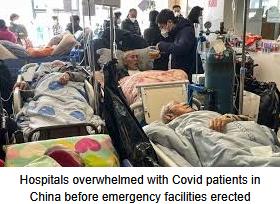
Dr. Sinha and colleagues question whether the U.S. is in a more favorable position to respond to an epidemic than it was prior to the introduction of COVID. The U.S. was unprepared in 2020 despite recommendations by the Institute of Medicine and the National Academies of Sciences, Engineering and Medicine over 25 years ago. The federal and state agencies responsible for public health did not responded appropriately and efficiently as evidenced by events during early 2020. The early months of the COVID outbreak were characterized by institutional denial, a search for ‘quick fixes’, a lack of personal protective equipment and imperfect coordination among federal agencies. These inadequacies should have been corrected in intervening years but it is evident that little has changed. In some respects, the legal environment is less conducive to a coordinated and scientifically appropriate response.
 During the early weeks of acceptance that the H5N1 B3.13 mammalian-adapted strain was transmissible to humans, operators of dairy herds were disinclined to cooperate with either state or federal agencies to initiate appropriate surveillance. In the state of Texas, the Commissioner of Agriculture was on record as characterizing the efforts by the Centers for Disease Control to determine the extent of exposure of workers as “overreach”. During the early weeks of acceptance that the H5N1 B3.13 mammalian-adapted strain was transmissible to humans, operators of dairy herds were disinclined to cooperate with either state or federal agencies to initiate appropriate surveillance. In the state of Texas, the Commissioner of Agriculture was on record as characterizing the efforts by the Centers for Disease Control to determine the extent of exposure of workers as “overreach”.
Dr. Sinha correctly characterizes the response to H5N1 as uncoordinated with ill-defined areas of jurisdiction among the Department of Health and Human Services subsidiary agencies comprising the Centers for Disease Control and Prevention, the Food and Drug Administration, and the National Institutes of Health and the Departments of Defense, Agriculture and Homeland Security. In addition individual state governors created self-serving policies with their departments of health and of agriculture involved at the case and plant levels. Initially the White House designated the Secretary of the Department of Health and Human Services as the coordinator but this rapidly degenerated into a free-for-all with no indication of “who was in charge”.
With the emergence of bovine influenza-H5N1 cooperation between state departments of agriculture and their public health counterparts expedited programs of surveillance. This involved both herds and workers and state agencies that undertook to educate owners of farms and their workers on protection. Michigan and Colorado were preeminent in actively addressing the problem with Colorado introducing a mandatory testing program involving milk samples from all herds to detect the presence of virus and to impose quarantine measures.
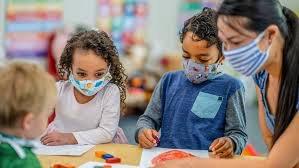
In the event, it appears that H5N1 does not represent an immediate concern for public health. Notwithstanding this fortunate circumstance, the threat of an emerging epidemic reveals obvious restraints to addressing what might occur in the future. An outbreak involving a human-adapted pathogen that is also contagious has the potential to spread rapidly and extensively. If a severe form of human influenza emerges it would probably affect children disproportionately. State and local authorities applying experience from COVID would be disinclined to close schools or to mandate masking, supported by state regulations and court decisions. The initial response of state officials in traditionally conservative regions would be to place personal freedoms above sound principles of disease prevention especially in the early stage of an epidemic when control measures would have the potential for the most favorable outcome.
A rising wave of science-skepticism and an unjustified lack of confidence in public health agencies including the Centers for Disease Control and Prevention would impair the development, coordination and implementation of containment measures following the emergence of an infection with epidemic potential.
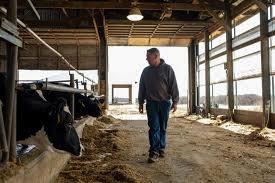
Proposed changes affecting the tenure of federal employees together with traditional pressure to conform to institutional norms is likely to inhibit open discussion of alternative modalities and would stifle the development of appropriate policy. Attempts to impose censorship on scientists and public health specialists as occurred during the COVID period will become more intense and absolute in the event of a subsequent epidemic. The recent overturn of the Chevron Doctrine eliminated deference to scientists and medical professionals and would impede their efforts to introduce emergency measures intended to reduce the incidence rate of an infection. Directives based on scientific principles would be subject to interdiction by courts and result in prolonged litigation as rulings are appealed.
Expenditure on vaccine development as evidenced by the “warp speed” production of mRNA vaccines that effectively provided protection from COVID among those receiving vaccines will probably be politically unpopular. Even if mRNA technology can be applied to developing a vaccine against a new virus, prevailing vaccine hesitancy supported by misinformation on social media would limit administration allowing an infection to spread among the susceptible proportion of the population.
It is hoped that the incoming administration, irrespective of political persuasion, will recognize the inevitability of a future epidemic and will respond to the obvious deficiencies that occurred during the early COVID period. Those responsible for our Government should take heed from the emergence of H5N1 among dairy herds albeit with only a few workers affected who were involved in depletion of infected egg-production flocks. Events since March suggest acceptance of the One Health principle with regard to the emergence of a zoonotic infection. Bovine influenza H5N1 was a warning—the next pathogen to emerge or a mutation of an existing benign human or animal virus currently circulating may not be as forgiving going forward.
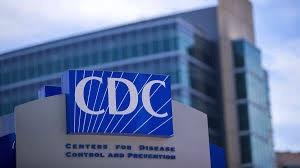
There will be no simple and inexpensive solution to contain a future epidemic. The economic implications of an outbreak in a susceptible population will inevitably lead to disruption in food and industrial production, will curtail everyday activities and represent the potential for extensive mortality. The consequences of a contagious infection of zoonotic origin can be ameliorated by preemptive planning and the application of proven epidemiologic practices. This will involve embracing science and selecting hard choices that may, in the short term, be politically unpopular. The U.S. and the World could face a 1918 “Spanish flu” situation at some time in the future. We are woefully unprepared with respect to political and public acceptance of control measures. We are faced with a hostile legal environment to implement meaningful protection coupled with a fractured system of jurisdiction over public health. We need to use whatever time is available before the next outbreak to develop action plans that are cohesive and epidemiologically valid.
*Sinha, M.S. et al. (2024) Déjà vu all over Again-Refusing to learn the lessons. New England J. Medicine 391:481-483. DOI 10.1056/NEJMp2406427.

|
Enhancing Margins Through More Aggressive Marketing Strategies
|
08/27/2024 |
|
 The Aldi chain of supermarkets in the U.K. has announced that all eggs sold in its stores will be from flocks housed as cage-free. Although fourth in size among U.K. supermarket chains, Aldi is a leader in free-range eggs produced on domestic farms. The Aldi chain of supermarkets in the U.K. has announced that all eggs sold in its stores will be from flocks housed as cage-free. Although fourth in size among U.K. supermarket chains, Aldi is a leader in free-range eggs produced on domestic farms.
In recent years, major U.K. chains have ignored requests for higher transfer prices especially after the Brexit misadventure that resulted in a sharp escalation in the cost of feed, energy and other inputs. Failure to rise above breakeven resulted in many producers ceasing production as they exhausted working capital. This in turn resulted in shortages and rationing by specific chains that were unable to recognize the consequences of their myopia.

Through financial turbulence, Aldi maintained a practical business relationship with suppliers, invested up to $60 million the form of subsidies and entered into long-term contracts that sustained their supply farms through financial challenges.
Julie Ashfield, Managing Director of Supply Chains at Aldi U.K. stated, “Our British suppliers are at the heart of our business and without them Aldi would not be where it is today, and we are proud to work with so many U.K. egg farmers.” She added, “By working with our suppliers we have been able to hit our cage-free target more than a year early.”
It is hoped that Aldi in the U.S. will follow the lead of its sister company in the U.K. and their policy will be emulated by U.S. chains. It is noted that conversion from conventional cage housing to alternatives including barns, aviaries and to a lesser extent, free-range, have been financed by individual producers including family farms and companies despite prices being limited by straightforward supply and demand constraints. For decades the supermarket chains have benefited from investments made by egg producers who are ill-served by the prevailing benchmark pricing system that favors chain buyers in negotiating prices. Failure to allow producers to recover their fixed costs including fair depreciation and interest limits ex-plant margins and inhibits the installation of improvements and upgrades. The policy of minimizing prices is especially to the disadvantage of smaller operators who do not have the benefits of scale of production.
The ongoing avian influenza epornitic since 2022 with seasonal pauses in incidence rate has resulted in an average reduction in the size of the producing flock by approximately 20 million hens. This has contributed to an escalation in price attributed to disequilibrium between supply and demand and has in some measure reduced the bargaining power of chains. With restoration of flock size given the maturation of 20 million pullets per month, prices will inevitably fall especially if additional losses do not occur in fall and early winter as in previous years. As transfer prices decline, it is hoped that chains will reduce shelf prices proportionately to sustain demand. Maintaining high retail prices with declining wholesale values is detrimental to both consumers and the production sector and represents a form of price gouging.

There is concern that in public statements, Doug McMillion president and CEO of Walmart Inc. has indicated that producers and food manufacturers can expect price pressure from Walmart, the nation’s largest food retailer. Although the initiative for lower prices by Walmart is directed in the first instance towards processed and dried food it is inevitable that produce and eggs will follow. A spokesman for TD Cowen noted, “We expect pressure from Walmart for deeper price rollbacks to continue especially in categories where Walmart can flex its private label merchandising.” John David Rainey, CFO for Walmart stated, “We are advocating for our customers, we want to drive our everyday low prices and we are not intending to achieve any of our margin performance by passing this along to our customers and Sam’s Club members in the form of higher prices.”
The implication is obvious, Walmart and by association all major chains want to keep prices low to maintain traffic but are obviously averse to smaller margins. It does not take a CPA to determine who will bear the brunt of the initiative. The situation will be exacerbated if the merger between Kroger and Albertsons were to become a reality since promises made to reduce prices in the short term would be coupled with intensified buying power affecting both national and regional producers.

Despite greater scrutiny of margins and profits generated by retailers, through their shelf prices, pressure on producers will continue for the foreseeable future. Appropriate approaches for the industry would be:-
- strive for greater efficiency,
- establish Capper-Volstead marketing cooperatives,
- promote a CME market for generic Midwest Large in place of the current benchmark price discovery system that functions to the disadvantage of producers,
- diversify product range with more specialty eggs,
- develop new egg-based products for food service and QSR markets
- demonstrate restraint in expansion without participating in any form of collusion.
Enhancing returns to producers will require adoption of novel strategies to counter the power of the major chains.

18 weeks below breakeven in a down market |

|
North America Gains Reprieve from the Canadian Rail Strike
|
08/27/2024 |
|

The rail strike in Canada, albeit of short duration has ended. The Federal Government invoked Section 107 of the Canadian Labor Code requiring binding arbitration between the Teamsters Canada Rail Conference and the two major rail operators, Canadian National Railway (CNR) and Canadian Pacific Kansas City (CP-KC).
As noted in postings in the August 23rd edition of EGG-NEWS, the Union demanded increased wages and benefits and above all, rationalization of work schedules especially affecting long- distance freight to enhance safety and morale.

The Liberal Party government that is generally Union-friendly was forced to act by the impact of a rail strike on all aspects of the Canadian economy. Moody’s the multinational ratings agency estimated that the strike could impose a cost of $250 million per day.
Associations representing segments of Canadian agriculture including the Meat Council, Pork Council and others petitioned the Government for intervention since transport involving perishable commodities requires stable and reliable rail operation to support supply chains and avert waste. The associations cited the 2023 strike in the Port of Vancouver that extended over 35 days and disrupted trade to the value of $8 billion.
It is not only Canada that would have been affected by a major rail strike. The two operators intersect with U.S. operators, BNSF Railway, Union Pacific, Norfolk Southern and CSX. Canadian National Rail links extend to New Orleans, LA. and CP-KC extends to Gulfport, MS. and on to Tampico on the east and Lazaro Cardenas on the west coast of Mexico. Approximately one-third of all traffic moved by the two major rail operators in Canada crosses the border with the United States.
Commodities affected by even a short-term rail strike in Canada would include ethanol, potash, grains, oilseeds, oils and above all fresh meat. Apart from agriculture, industry would be impacted since Mexico manufactures automobile parts that are required to assemble vehicles in the U.S. and Canada. In turn, Canada exports wheat, meat and aluminum southward to the U.S. and Mexico.
In 2023, the U.S. exported $30 billion in agricultural products to Canada, balanced by imports of valued at $40 billion. Combined trade between Canada and Mexico amounted to $40 billion.
The economies of Canada, the U.S. and Mexico are interconnected requiring reliable and efficient transport. Disruption in any of the three conjoined USMCA partners will have serious impacts on the economies of the other two.
The consequences of rail strike in Canada should generate a sense of urgency to conclude negotiations for a labor contract between longshoremen along East coast and Gulf ports and operators of these critical facilities. Time is running out with a September deadline now imposed by the International Longshoremen’s Union.
As with Canada, strikes affecting major industries and especially the transport sector have political implications. This is even more critical in a U.S. election year and also in Canada where the governing party has a tenuous hold on power.

|
|
|
|
View More
|
Top
|
|